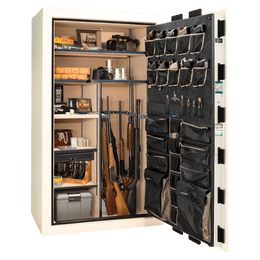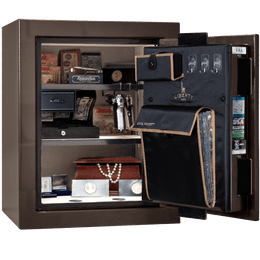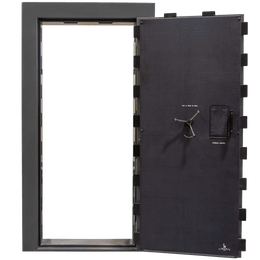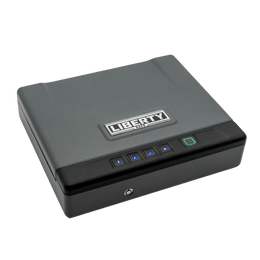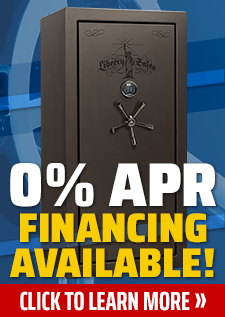One question that “gun guys and gals” are frequently asked is, “If you could only have one gun, what would you choose?” While that scenario is potentially horrifying for people who enjoy collecting and shooting multiple types of guns, it is a reasonably realistic possibility for people who, for cultural, financial, legal, or personal reasons, only want or need (or can possess) one firearm, which must perform well in multiple roles.
Table of Contents
So, is it possible for one firearm to reasonably meet all requirements for potential use for personal defense, home defense, hunting, recreational shooting, and even WROL (without rule of law/end of the world) type scenarios? Let’s take a look at a couple of potential options to consider, and then we’ll let you know our pick for one gun that can do it all.
Why would someone only be able to own one firearm?
The reasons for only having one firearm are myriad and varied. Here are just some of the potential reasons:
Legal: In some jurisdictions, it’s very difficult to obtain legal permission to even have a firearm in your home. Expensive classes, background checks, fingerprinting, target range qualifications, and/or yearly renewal fees may apply. It can be a huge hassle, and some people may only want to undergo the red tape for one firearm. Additionally, certain types of firearms (semi-automatic firearms in general, or handguns in particular) may not even be legal to possess at all in some jurisdictions, with or without a permit. This can severely limit some people’s desire to own more than one firearm.
Financial: Firearms can be expensive, or they can be fairly cheap to own and operate, but those are relative terms. For some people, coming up with an extra $200 for an inexpensive shotgun or rifle might be more than they want to spend. And once they have a firearm that meets their needs, they may not see the reason to spend more on another one.
Personal preference: Some people just don’t “like” guns very much, nor do they have a background of hunting, shooting, and recreating with firearms. This is perfectly fine. However, for whatever reason, be it a need for an “emergency weapon” or something to protect the house, or something to keep pests and predators away from crops or livestock, even these non-gun-people may want to keep one versatile firearm as an effective tool. It may even be a decision made between spouses to have a single gun in the home for protection, but “we’re not getting any more guns.”
Furthermore, a person who has one firearm and trains with it regularly can be very effective compared to someone who may own many guns but rarely shoots them or practices with them. There’s an old adage attributed to Jeff Cooper: “Beware the man with one gun.”
There may be many other reasons to only have one firearm. So, in that eventuality, what firearm would be the best choice? Let’s go over a few potential options and see if we can shed some light on the pros and cons of each.
The .22 rimfire rifle
One reasonable choice for a “do it all” firearm is a .22LR caliber rifle. “What?? A measly twenty-two?” you might be asking. Well, hear us out. Here are some things in favor of the .22 rifle.
A .22 rimfire rifle is an extremely versatile firearm
In addition to super-fun plinking and target shooting, a .22 rifle can be used for a lot of “only one gun” purposes. For small game hunting, it’s a traditional favorite, though it may not be as easy to hit little targets or running game as with a shotgun. Where legal, you can even hunt game birds like grouse or pheasant (or even turkey) if you’re a good enough shot and are stealthy enough to stalk them on the ground (don’t try to shoot them in the air). Squirrels and other small game are within the realm of a .22 rifle for sure.
In an emergency/TEOTWAWKI (the-end-of-the-world-as-we-know-it) situation, a .22 rifle can be used to hunt deer-sized game as well. There are many accounts of native and subsistence hunters taking deer with a .22. It’s not ideal for sure, but it is doable.
For defense against an attacker in a home-defense situation? A .22 rifle is not ideal but is certainly better than nothing. Modern .22LR bullets in ballistic testing go pretty much all the way through a man-sized target, and, with the right expanding rounds such as CCI Mini-Mags, can do a good amount of damage along the way, particularly if you are able to hit with multiple shots (which is fairly easy with a .22 semi-automatic rifle). A semi-auto would probably be better than a bolt-action in this scenario.
The cost of a reliable .22 rifle is relatively low
Whereas with centerfire, semi-auto rifles and shotguns, there’s typically a threshold of about $500-$600 that you don’t want to drop below if you want a reliable gun, this doesn’t apply to .22s. You can typically get a very reliable semi-automatic .22LR rifle for under $300 and sometimes much less. For people that are concerned with spending too much on a firearm, this can be a great choice. Bolt-action .22s can be even less expensive, if that’s your personal or legal preference.
.22 Long Rifle ammunition is inexpensive and (usually) plentiful
“Inexpensive ammo” is a relative term lately, but .22LR ammunition is almost always much less expensive than pretty much any centerfire cartridge. When 9mm ammo (usually the least expensive centerfire cartridge in America) was $.16 per round, .22LR was around $.03 per round (those were the days!). When 9mm jumped to $.40 per round, .22 could be found for $.08 or $.10 per shot. Regardless, you’re sure to get more shots for your dollar with .22.
.22 Long Rifle is by far the most popular cartridge in America, with around 5 billion rounds manufactured and sold each year, compared to about 4 billion for all other centerfire cartridges combined. Also, since it’s lightweight and small in dimensions, you can buy and store a lot of .22LR ammo in a very small space, if you want to stock up. If you foresee being on foot when the zombies come, you can carry 500 or 1,000 rounds of .22 ammo relatively easily.
A .22 rifle is legal in many restrictive jurisdictions
In some states, counties, and cities, a handgun of any type is difficult or impossible to legally own, and in these jurisdictions, sometimes a .22 rifle is easier to get a permit for. If all semi-automatic firearms are banned in your area, there are good lever action, pump-action, or bolt action .22 rifles that can serve you well.
A .22 rifle is low-recoil and relatively quiet
Ask anyone who has fired a handgun or a high-powered rifle indoors (or even outdoors without hearing protection) and they’ll either say, “Pardon me??” or tell you that it rang their bell. Big, powerful guns are extremely loud. A .22 rifle, particularly a bolt-action or lever-action with a longish barrel, is relatively quiet, and of course recoil is a non-issue. For some shooters, these two factors alone make the .22 rifle the right choice for them.
Downside of a .22 rifle if you can only have one firearm
First, you can’t really conceal-carry a rifle, even the smaller takedown versions, so if that duty is one of the reasons you own a gun, a rifle is not appropriate from the start. Secondly, though the .22 is capable of being pressed into a home-defense or WROL role, it’s certainly not ideal. The .22 is potentially lethal but in most cases, it’s not immediately lethal. There just isn’t enough velocity or energy to do a massive amount of damage with one shot. And third, though .22 ammo is common and inexpensive, it’s not as reliable as centerfire ammunition, due to its rimfire priming system and heel-based, outside-lubricated bullet. If you absolutely, positively must have a cartridge fire when you pull the trigger, a .22 rimfire is probably not your first choice.
So, which .22 rifle would be a good choice for an "only" gun?
The Ruger 10/22 is a perennial favorite and they are generally as reliable as the proverbial stone axe, as long as you use the factory magazines. Aftermarket support for this platform is unparalleled. If we were going to be restricted to a single .22 caliber rifle, this is the one we’d pick. You can get a lot of bullets on target quickly if needed, and it’s extremely fun to shoot. However, it’s a semi-auto, which may be a plus or a ding depending on where you live and what your intended purposes are.
If you can’t own a semi-auto and want the ability to shoot fairly rapidly, there are several good lever-action .22 rifles, such as the Henry, Browning BL-22, and Marlin 39A (if you can find a good one used), and generally these are faster to shoot multiple shots from compared to a bolt-action rifle, but generally won’t have the same potential for fine accuracy, if that’s a factor in your decision.
For an inexpensive bolt-action rifle that punches well above its weight class, check out the Savage Mark II FV-SR. It retails for under $300, features a fluted, threaded barrel for great accuracy and easy suppressor attachment, and includes a sturdy one-piece picatinny rail for mounting your preferred optic.
The pump action 12-gauge shotgun
Another front-runner in the search for an "only" gun is a slide-action or “pump” 12-gauge shotgun from a reputable maker. When versatility is the goal, no other firearm offers what a shotgun does. Let’s go over some of the key advantages.
Shotguns are the most versatile firearms ever made
A bold statement, but few informed people would disagree. Shotguns are excellent at home defense, unparalleled at bird/small game hunting and clay games, and very effective at hunting medium and large game at reasonable ranges. There’s no other type of firearm that can do everything that shotguns do.
You can hunt anything, birds, small game, deer, etc. with the same gun
Even if you don’t change barrels, a basic shotgun is capable of hunting all types of game, including waterfowl, upland game, small game, medium-sized game, and large game, depending on your choice of ammunition. A smoothbore shotgun with the proper choke can be remarkably accurate with slugs out to 100-150 yards or more. To learn more about the various types of shotgun shells and their capabilities, refer to our Shotgun Ammo 101 article.
You can change pump shotgun barrels easily and quickly
With most of the popular pump-action shotgun models today, changing barrels to a longer, shorter, or rifled barrel is a simple, 1-minute swap. Several manufacturers such as Mossberg sell “combo” shotguns that come with both a longer ~28” bird-hunting or clay-shooting barrel as well as a shorter ~18.5” “tactical,” home-defense, or rifled deer-hunting barrel, and they can be swapped at will depending on your desired use. This results in a very effective and versatile package.
Shotguns are extremely powerful home-defense firearms
A pump-action shotgun in the hands of a well-practiced shooter is an excellent home-defense firearm, and if you choose the right ammunition, can help prevent overpenetration through internal and external walls. For more info and specific models to consider, see our Best Home Defense Shotguns article.
Shotguns are legal in nearly all jurisdictions (where firearms are legal)
Another plus for a shotgun is that even in notoriously un-gun-friendly states and counties, break-action or pump-action shotguns are often legal even where semi-automatic rifles or handguns may not be. If this applies to you, a shotgun is not just a good choice for an “only” gun, it might actually be the only choice.
Pump action shotguns are relatively inexpensive
While a reliable AR-15 will likely cost you at least $600 and they can go up to $2,000 or more, a reliable pump shotgun can be had for around $200 and they rarely go over $550 for “combo” guns with 2 barrels. Mossberg, Remington, and Winchester are the go-tos, but Savage/Stevens offers inexpensive knock-offs that are generally well regarded. We’d stay away from the cheap, off-brand Turkish manufactured pumps for the time being, as they are generally not shown to be as durable and well-made as the Chinese knock-offs or even the cheapest Mossberg/Maverick pumps.
Shotgun ammo is generally available
Similar to .22 ammo, shotgun ammo is almost always available (when ammo is generally available nationally). Many rural hardware stores will carry a few boxes of shotgun shells, even if they don’t sell guns. You may have a hard time finding the exact load you want, particularly in gauges other than 12, but it’s almost assured that you’ll be able to find some sort of shotgun ammunition, and almost all of it will work for emergency/defensive use.
Disadvantages of a pump shotgun for an "only" gun
Though a "combo" 12-gauge pump like the Mossberg 500 pictured below would be our pick for the shotgun category if we could only own one gun, there are some downsides. Recoil can be fierce, particularly for small-statured, inexperienced shooters. You certainly can’t stuff a shotgun in your belt and CCW carry it, so that’s off the table if concealed carry is a consideration for you. A pump shotgun is actually pretty complicated to load, unload, and use safely, particularly if you haven’t practiced. Unlocking the bolt without firing a shot is the thing most people have trouble with, and you’ll definitely want to read the manual for your individual firearm model and learn how that works. Ammo capacity is very low compared to most rifles, as well. Still, of all the options here, the shotgun would be our overall second choice, due to its amazing versatility. See the bottom section below for our first overall pick.
The AR-15 rifle
"America’s rifle" is a good option as an "only gun" if you can legally own one where you live. The AR platform does a lot of things well and has come a long way since its origins in the early days of the Vietnam conflict. Let’s look at the pros and cons of this popular rifle, and help you decide if it can make sense as your "only firearm."
AR-15s are very effective in-home defense or WROL situations
The lightweight, high-velocity round fired by the most common ARs has been proven extremely effective against man-sized threats. The rifles are relatively light, short, and easy to manipulate. In common configurations, 30-round magazines are typical, and those magazines are very inexpensive, reliable, and commonly available. A good shooter with a good AR can make effective hits on human-sized targets out to 300 yards with a red dot, or 500-600 with magnified optics.
An AR-15 can be effective at hunting small and medium-sized game
If your only firearm must also be used for hunting, an AR can fill that role. They can be made to be very accurate, so headshots on small game can prevent damaging too much meat. A good .223 hunting load can be an effective deer-hunting round, though it’s not ideal and most people would choose something larger if they had the choice.
ARs have much less recoil than most shotguns
The huge payload and enormous power that makes shotguns good at stopping threats also come with a lot of recoil, but the AR-15 is a pussycat in that regard. The energy and devastating wound capability of the .223/5.56 round comes primarily from its very high speed, and since the bullet itself is extremely light, recoil is relatively low. This can help new shooters and smaller-statured users shoot the rifle well.
Potential downsides of the AR-15 as your "only firearm"
In recent decades, no other firearm has come under such legal, legislative, and social pressure as has the AR-15. It’s typically the first firearm that is named when a state, county, or city decides to try to ban guns out of existence. In some places, it’s not legal to hunt deer with an AR-15, if that’s a consideration for you. Like the .22 rifle and shotgun above, you can’t really press an AR-15 into a concealed-carry role. ARs are extremely loud, which can be a factor if you ever need to fire one without hearing protection, especially indoors. Ammunition can be expensive and often becomes unavailable in times of panic buying. You certainly aren’t going to be hitting many airborne targets or birds with an AR-15. And finally, a good AR will generally be half-again as much as a high-quality pump shotgun, and may be double, triple, or quadruple the cost of a budget, but still reliable shotgun or .22 rifle.
Our top overall choice for an only gun: A medium-frame .357 magnum revolver with a 4-inch barrel
As discussed above, a .22 rifle, pump-action shotgun, or AR-15 could fill your needs for an only firearm, as long as you don’t care about carrying a concealed handgun. If concealed carry is a consideration, and your “only gun” has to fill this role as well as all the others, then those three choices must necessarily be eliminated in favor of a handgun.
While the argument could be made that an “only” gun that needs to fill the CCW role should probably be a medium or full-sized semi-automatic pistol like a Glock 17, Beretta 92, SIG P320, or something along those lines (and those are all very good choices), for the sake of meeting the needs of most people, in our view, a superior firearm–if you could only have one–would be a good-quality .357 Magnum revolver with around a 4-inch barrel, such as a Ruger GP100, Colt King Cobra, Kimber K6S, or Smith & Wesson Model 686.
The advantages of this type and size of handgun are many:
- You can carry it concealed where it is legal
- You can chamber and fire both powerful .357 Magnum and light-recoiling .38 Special ammo with equal reliability, and with no adjustment to the revolver
- Ammunition is quite common (the most common centerfire revolver cartridge) and not too expensive
- Quality revolvers are extremely reliable when used and maintained properly
- Revolvers are super fun to shoot
- You don’t have to pick up your brass if you reload (you can eject the empty cases into your hand or any other receptacle)
- A steel-framed 4” revolver isn’t too punishing to shoot with full-house .357 loads, and recoil is minimal with .38 Special loads
- A 4” barrel is long enough to get the .357 Magnum bullets moving at close to their maximum potential speeds, and the revolver remains a manageable overall size for CCW. Snub-nosed revolvers are easier to hide and carry, but the short barrel hampers .357 velocity and the tiny, lightweight pocket revolvers are more punishing to shoot
- You can certainly hunt deer-sized game with a .357 Magnum (where legal), as well as small game with lighter loads
- A revolver is very simple to load and fully unload compared to other firearms
- A 4” .357 Magnum revolver would be a very good choice as a home-defense firearm
So, which one would we pick? It’s hard to beat the Smith & Wesson Model 686 .357 magnum revolver. With a 4.125” barrel, a stainless finish for corrosion resistance and ease of cleaning, comfortable grips, intuitive controls, available 7-round configuration, excellent accuracy, and one of the nicest triggers in the business, the 686 is a top seller for a good reason. The suggested list price is $959 but you can find them for much less. The fully steel revolver isn’t a lightweight (at 39.7 ounces empty in the 4” model) but that heft helps soak up the recoil of the powerful .357 Magnum round, and it’s essentially the same weight as a Colt 1911, which many people carry daily without issue.
There you have it: our overall top pick for the one gun we’d own if we could only own one gun.
Keep your gun (or guns) secure in a Liberty safe or handgun vault
Whatever you choose, whether you only own one firearm or many, it’s important to keep your guns and valuables out of the reach of anyone who shouldn’t have access. Liberty makes a complete line of top-selling, USA-made gun safes and handgun vaults for any budget, and any size gun collection. Check out our online catalog, or locate a dealer near you.
*Made in the U.S.A. from U.S. and Global Parts.


